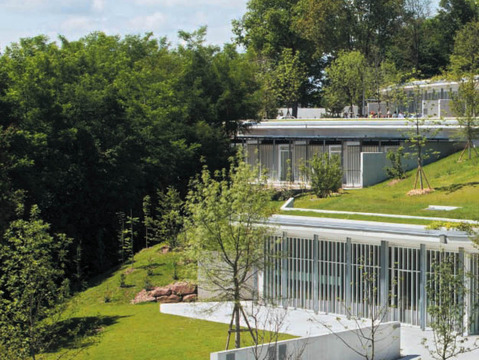“Percorsi in ceramica”
Piano lessons
January 09, 2013

Renzo Piano’s work viewed through two of his projects Carried out with Casalgrande Padana
Once again, “Percorsi in ceramica” focuses its attention on the relationship binding Casalgrande Padana to the design process and output. Working hand in hand with architects, supporting their ideas and e promoting their very creation, is for the company the key methodological approach. This particular approach involved remarkable feats side by side with international markets, such as Renzo Piano, with whom Casalgrande Padana shared important projects.
For Renzo Piano “to design is to explore, it is what one could define the adventure of thought”. This endeavour, in the forty-year experience of the Genoese master, has always had to come to terms with the appropriateness of the employed material. Among these, ceramic and earthenware have been involved in a very particular development process and proved ground for ceaseless experimentation, so much that both stretched beyond the traditional boundary between form and facing, searching the depths of unexplored opportunity for development and integration. As an example from the recent past, think of the most advanced envelope systems that integrate ceramic elements and were designed for several projects, including the ex-area Falk in Sesto San Giovanni (not completed), as well as the famous New York Times skyscraper in New York and the equally famous Central St. Giles complex in London.

Along its path Casalgrande Padana has started a close collaboration with the Renzo Piano Building Workshop for the development of several projects, including Auditorium Niccolò Paganini in Parma, Villa Nave (Headquarters of RPBW and Fondazione Renzo Piano) in Genoa (Vesima), the Visitor Center and Saint Clare Monastery in Ronchamp, a massive infrastructural project at the service of one of Le Corbusier’s best masterpieces, the Ronchamp Chapel and, last but not least, the new Pirelli Tyre industrial complex in Settimo Torinese. The story of some of the above experiences is the backbone of this issue of “Percorsi in Ceramica”, bearing testimony to the indissoluble link between production and design, which has always been at the core of Casalgrande Padana’s development strategy.
 Centro Visitatori e Monastero Santa Chiara presso Ronchamp (ph. Michel Denancé)
Centro Visitatori e Monastero Santa Chiara presso Ronchamp (ph. Michel Denancé) Centro Visitatori e Monastero Santa Chiara presso Ronchamp (Renzo Piano Building Workshop)
Centro Visitatori e Monastero Santa Chiara presso Ronchamp (Renzo Piano Building Workshop) Centro Visitatori e Monastero Santa Chiara presso Ronchamp (ph. Michel Denancé)
Centro Visitatori e Monastero Santa Chiara presso Ronchamp (ph. Michel Denancé) Centro Visitatori e Monastero Santa Chiara presso Ronchamp (ph. Michel Denancé)
Centro Visitatori e Monastero Santa Chiara presso Ronchamp (ph. Michel Denancé) Centro Visitatori e Monastero Santa Chiara presso Ronchamp (ph. Michel Denancé)
Centro Visitatori e Monastero Santa Chiara presso Ronchamp (ph. Michel Denancé) Centro Visitatori e Monastero Santa Chiara presso Ronchamp (ph. Michel Denancé)
Centro Visitatori e Monastero Santa Chiara presso Ronchamp (ph. Michel Denancé) Centro Visitatori e Monastero Santa Chiara presso Ronchamp (ph. Michel Denancé)
Centro Visitatori e Monastero Santa Chiara presso Ronchamp (ph. Michel Denancé)
The second part of the issue is focused on production, with two important features presented at the latest Cersaie. One is the new Granitogres Architecture series, which was expanded in terms of solutions with new décor, colors, textures and surface finishes.
The new Bios Self Cleaning Ceramics® self-cleaning stoneware tile line, the result of a partnership between Toto, a Japanese company and absolute leader in photo-catalytic coating with its Hydrotect® brand. These two new solutions offer new perspectives to architecture and design, which stem from the relentless commitment to research and innovation Casalgrande Padana has always stood out for.
Go to Casalgrandepadana
Download
Percorsi in ceramica 26 ita_eng
back to top print
Post-it
ISSN 2239-6063
edited by
Alfonso Acocella
redazione materialdesign@unife.it